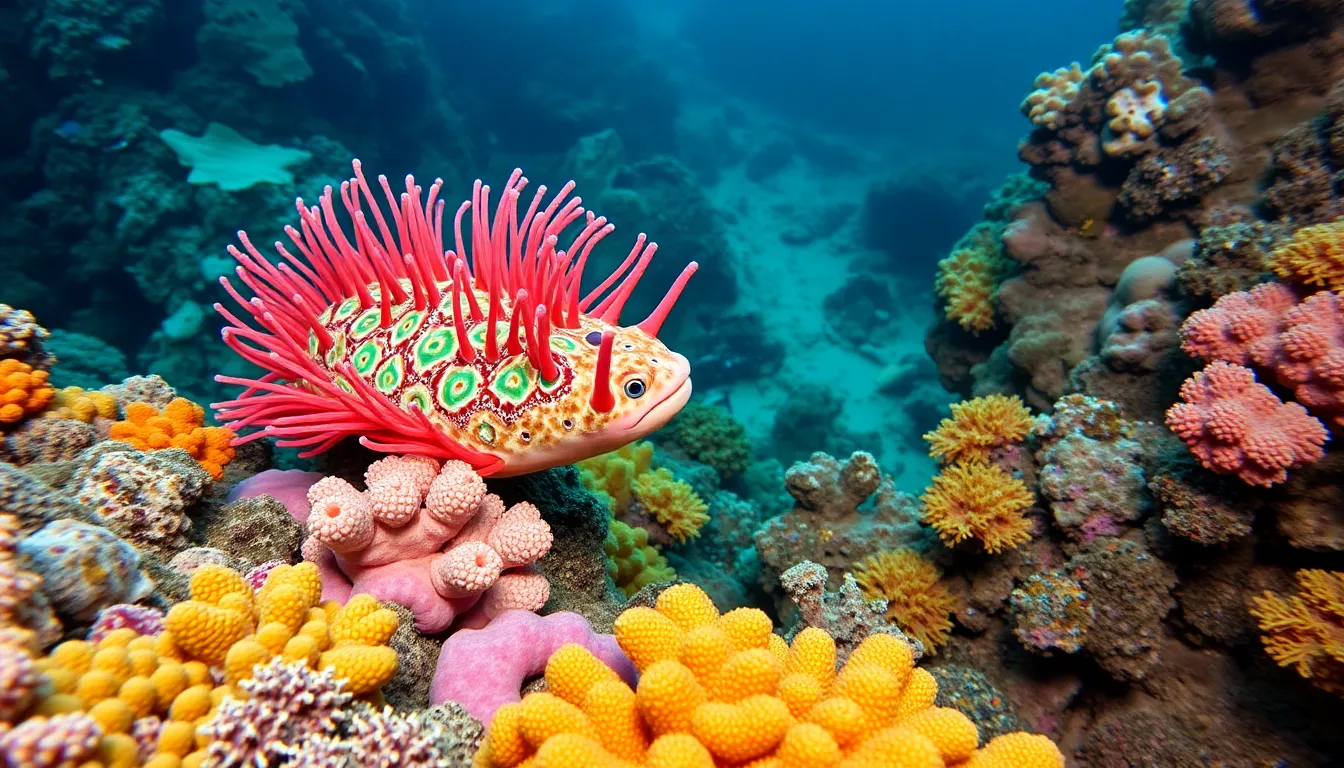Beneath the shimmering waves of the Safukip Sea lies a bizarre world teeming with some of the strangest creatures you’ll ever encounter. Forget the usual dolphins and colorful fish; this underwater realm boasts wacky residents that could easily star in their own reality show. From the flamboyant sea cucumber that looks like it just stepped off a disco floor to the elusive blobfish, these oddballs redefine what it means to be “unique.”
Table of Contents
ToggleOverview of the Safukip Sea
The Safukip Sea boasts an extraordinary ecosystem filled with bizarre marine life. Located in an isolated region, this body of water features unique geological formations that contribute to its diverse habitats. Shallow reefs, deep trenches, and underwater mountains create niches for various organisms, allowing them to thrive.
Marine biologists estimate that over 2,000 species inhabit the Safukip Sea, many of which display unusual adaptations. One notable inhabitant is the flamboyant sea cucumber, known for its vibrant colors and distinctive shapes. This creature’s ability to regenerate and camouflage itself adds to its intriguing nature.
Another remarkable resident is the blobfish, recognized for its unusual appearance. Found at depths of 600 to 1,200 meters, this gelatinous fish survives extreme pressures. Its shape changes drastically when brought to the surface, leading to its reputation as one of the ugliest animals in the world.
Temperature plays a crucial role in the ecosystem. Often ranging from 10 to 20 degrees Celsius, the water temperature impacts growth rates and reproductive cycles of many creatures. Organisms have adapted to endure cooler temperatures, influencing the overall diversity of marine life.
Depth variations also contribute to biodiversity. Coastal areas teem with life, while the deep sea remains a mystery, harboring species rarely observed by humans. Exploring these depths continues to reveal new and strange animals, enhancing the allure of the Safukip Sea.
Ecologically, the Safukip Sea’s unique characteristics result in a high level of endemism. Many species found here exist nowhere else on the planet. Conservation efforts are essential to protect this precious ecosystem from potential threats. Preservation of both its unique wildlife and delicate habitats maintains the health of the ocean.
Unique Ecosystem

The Safukip Sea features a remarkably diverse ecosystem that supports countless unique marine species. This vibrant habitat fosters a variety of interactions among its inhabitants.
Biodiversity in the Safukip Sea
Biodiversity thrives in the Safukip Sea, with over 2,000 identified species. Many of these organisms, like the flamboyant sea cucumber, display unusual adaptations. The deep trenches and shallow reefs create niches that allow for such specialization. Notably, numerous species are endemic to this region, not found anywhere else on Earth. This distinctiveness contributes to the overall ecological health and resilience of the habitat. Temperature variations also play a significant role, impacting growth rates and reproductive cycles. In total, these factors combine to create an intricate web of life in the Safukip Sea.
Importance of Habitat Preservation
Preserving the habitats within the Safukip Sea remains crucial for maintaining this biodiversity. Unique species rely on specific environmental conditions for survival. Pollution and overfishing pose significant threats to these delicate ecosystems. Conservation efforts focus on protecting vital habitats, such as breeding grounds and feeding zones. Sustaining these areas ensures the survival of endemic species. Healthy ecosystems are vital for the overall balance of marine environments. Community involvement in conservation initiatives encourages sustainable behaviors that can protect the Safukip Sea for future generations.
Notable Weird Animals
The Safukip Sea hosts several intriguing marine creatures that capture attention with their unique traits.
The Glowing Sea Jelly
Bioluminescence characterizes the glowing sea jelly. This jellyfish emits an ethereal blue-green glow, especially in dark waters. Notably, it attracts prey while deterring predators with its luminescence. The jelly’s tentacles can extend up to five feet, creating a mesmerizing display as it pulsates through the water. Found in varying depths of the Safukip Sea, these jellies thrive in areas with low light and abundant plankton. Their stunning visual effects contribute significantly to the ecosystem by drawing in various small fish and invertebrates.
The Dancing Squid
A remarkable sight, the dancing squid exhibits captivating behavior by changing its colors rapidly. This cephalopod uses chromatophores, specialized skin cells, to create vibrant patterns. Interestingly, it often engages in elaborate displays, attracting mates or confusing predators. The squid can reach lengths of up to 2 feet and prefer shallow coastal regions of the Safukip Sea. Their agile movements allow them to dart in and out of coral reefs, showcasing their striking appearance while hunting for shrimp and small fish.
The Frilled Shark
Known for its unique frilled appearance, the frilled shark resembles a creature from a bygone era. This species features a long, slender body equipped with 300 needle-like teeth, aiding its hunting of small fish and squid. Found at depths of up to 1,500 feet, it thrives in the mysterious depths of the Safukip Sea. Its distinctive gills, which resemble frilled lace, provide an efficient means of breathing underwater. The frilled shark primarily remains elusive due to its deep-sea habitat, revealing insights into evolutionary biology.
Adaptations of Weird Animals
The Safukip Sea is home to many strange creatures with remarkable adaptations that enhance their survival. Unique features like camouflage and unusual feeding habits play a critical role in their ecological niches.
Camouflage Techniques
Unique coloration and patterns help many creatures blend seamlessly into their environments. The flamboyant sea cucumber employs this technique by mimicking the colors of nearby corals, which aids in avoiding predators. Various species of octopus utilize chromatophores to alter their skin color and texture, allowing them to disappear against the ocean floor. Moreover, the translucent body of the glass squid includes an ability to become nearly invisible in the water. These adaptation strategies highlight the essential role camouflage plays in predator-prey interactions within this bizarre ecosystem.
Unusual Feeding Habits
Many odd marine species exhibit intriguing feeding behaviors tailored to their environments. The blobfish, for instance, uses its gelatinous body to float just above the ocean floor, consuming small crustaceans without exerting much energy. Meanwhile, the glowing sea jelly captures prey with its stinging tentacles while also attracting unsuspecting animals with its bioluminescence. Additionally, the frilled shark employs its unique jaw structure to consume fish and squid by quickly snapping them up in an action resembling a strike. These specialized feeding mechanisms illustrate how adaptations drive survival strategies among weird animals in the Safukip Sea.
Conservation Efforts
Conservation initiatives in the Safukip Sea focus on protecting unique habitats critical for unusual marine species. Efforts prioritize the preservation of breeding grounds and feeding zones vital to the survival of endemic creatures. Organizations collaborate with local communities to establish marine protected areas that limit human interference.
Awareness campaigns aim to educate the public about the ecological significance of the Safukip Sea’s biodiversity. Strategies include workshops, public service announcements, and interactive community events that highlight the uniqueness of its bizarre animals. Encouraging citizen science projects helps residents engage directly with marine monitoring activities, fostering a sense of stewardship.
Monitoring programs assess the health of marine ecosystems within the Safukip Sea. These programs gather data on pollution, species population trends, and habitat quality, which inform conservation strategies. Researchers utilize technology, including underwater drones and remote sensing, to track changes impacting iconic species like the glowing sea jelly and blobfish.
Legislation plays a crucial role in protecting fragile ecosystems. New policies aim to limit overfishing and reduce pollution entering the Safukip Sea. Implementations of stricter regulations and sustainable fishing practices contribute positively to the resilience of the marine environment.
Partnerships with international conservation groups enhance efforts for the Safukip Sea. Collaborative research projects enable knowledge sharing and resource allocation, strengthening the effectiveness of local conservation schemes. Now more than ever, cohesive efforts among various stakeholders promote a unified approach to safeguarding these extraordinary habitats for future generations.
The Safukip Sea is a treasure trove of bizarre marine life that captivates and intrigues. Its unique ecosystem is home to countless species that exhibit remarkable adaptations and behaviors. The vibrant interactions among these creatures highlight the delicate balance of their environment, making conservation efforts even more crucial.
As threats like pollution and overfishing loom large, protecting this extraordinary habitat becomes imperative. Community involvement and awareness are essential in ensuring the survival of these unique species. By prioritizing conservation initiatives, there’s hope for the Safukip Sea to continue thriving for generations to come. The wonders of this underwater realm deserve to be cherished and preserved.


